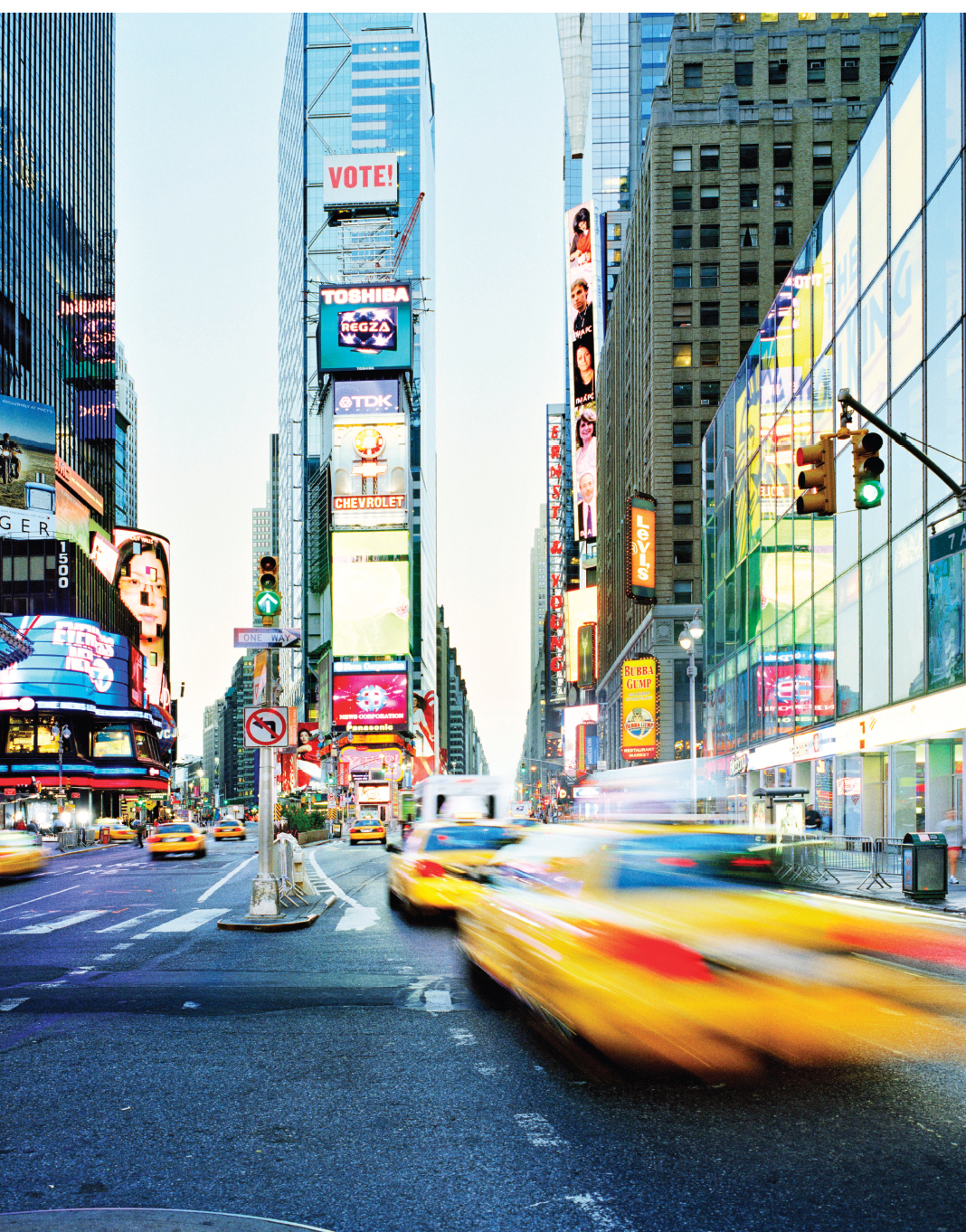Mass Communication: A Critical Approach
Printed Page 3
5
The Evolution of Mass Communication
11
Mass Media and the Process of Communication
14
A Closer Look at the Cultural Model: Surveying the Cultural Landscape
17
A Closer Look at the Social Scientific Model: Gathering Data
20
Media Literacy: Ways of Understanding
21
Critiquing Media

As this image from Times Square, New York, demonstrates, the media—in all their varied forms, from television news to online advertising—function as an essential part of our lives.
As new technologies become both greater in number and more widespread in use, our relationships to the media continue to change and deepen. Mass media are more adaptive and less contained than ever, and disconnecting from them is no longer as easy—or desirable—as it once was. In a recent study at the University of Maryland, two hundred college students agreed to go without media for a twenty-four-hour period and then write about their experiences. While some students did complain about the lack of access to MP3 players and the difficulty of avoiding television screens, for many of them the experiment felt more personal. Without text messaging, phone calls, e-mail, or Facebook, students felt cut off. “Going without media,” noted the project’s director, “meant going without their friends and family.”1 Engaging with media isn’t just a leisure activity; it’s a major component of how many of us live our lives.
Similarly, the nonprofit organization TV-Free America used to sponsor an annual “TV Turnoff Week” during which thousands of participants swore off television for seven days. The event was meant to prompt people to think about the place of television in their daily lives. The last “TV Turnoff Week” was held in 2008; TV-Free America has since changed its name to the Center for SCREEN-TIME Awareness (CSTA) and worked with the anticonsumerist group Adbusters to reinvent its media-abstinence campaign. The result of this collaboration is the reformulated “Digital Detox Week,” encompassing more than just television when it encourages consumers to turn off their screens (though underneath the description of Digital Detox Week on the Adbusters Web site is another, potentially contradictory message: “Get updates on Twitter”). This transition verifies that we have crossed a threshold into a media environment where screens affixed to smartphones, laptops, and tablets bring the powers of television, the Internet, books, and movie screens to almost any imaginable location.
THINKING ABOUT OUR RELATIONSHIP with all the small, medium, and large screens in our world generates many compelling questions. For example, what does research tell us about how media both reflect and shape our world? What roles and responsibilities do mass media have? What is our role in media processes such as the development and distribution of content? And how (if at all) should these processes be changed? In this book, we take up such questions by examining the history and business of mass media as well as scholarly research into how media and people interact. We take stock of the media’s positive and negative aspects, seeking ideas for ways to use media to improve the quality of our lives.
At their best, in all their forms, the media try to help us understand the events and trends affecting us. At their worst, they can erode the quality of our lives in numerous ways. For one thing, media’s appetite for telling and selling stories can lead them to misrepresent those events or exploit them (and the people they most affect) for profit. Many critics disapprove of how media—particularly TV, cable, and tabloid magazines—seem to hurtle from one event to another, often dwelling on trivial, celebrity-driven content rather than meaningful analysis of more important events. Critics also fault media for failing to fulfill their responsibility as a watchdog for democracy—which sometimes calls for challenging our leaders and questioning their actions. Finally, the formation and growth of media industries, commercial culture, and new converging technologies—smartphones, laptop computers, digital television—have some critics worrying that we are now spending more time consuming media than interacting with one another.
Like anything else, mass media have their good sides and bad, their useful effects and destructive ones. And that’s why it is so important for us to acquire media literacy—an understanding of the media that are powerfully shaping our world (and being shaped by it). Only by being media literate can we have a say in the roles that media play around us.
In this chapter, we take steps to strengthen that literacy by:
- tracing the evolution of mass communication—from oral and written forms to print and electronic incarnations
- examining mass media and the process of communication, including the steps a new medium travels on its journey to mass medium status, and the role that mass media play in our everyday lives
- considering two main models of media literacy—cultural and social scientific—which reflect different approaches to understanding how mass communication works and how media affect us
- taking a closer look at cultural approaches to media literacy
- taking a closer look at social scientific approaches
- exploring ways of critiquing the mass media and reflecting on the importance of doing so